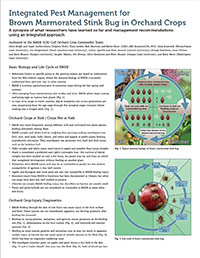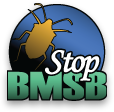Orchard Crops
Integrated Pest Management for Brown Marmorated Stink Bug in Orchard Crops
 This guidance document, authored by the BMSB SCRI CAP Orchard Crop Commodity Team, provides a synopsis of what researchers have learned so far and management recommendations using an integrated approach.
This guidance document, authored by the BMSB SCRI CAP Orchard Crop Commodity Team, provides a synopsis of what researchers have learned so far and management recommendations using an integrated approach.
Topics Include
- Basic Biology and Life Cycle of BMSB
- Orchard Crops at Risk / Crops Not at Risk
- Orchard Crop Injury Diagnostics
- Period of Risk/Susceptibility
- Provisional Monitoring and Scouting Recommendations
- Provisional Management Strategies
- Biological Control
- Effective Insecticides for Controlling BMSB in Orchard Crops
- Problems That May Arise from Multiple Post-Bloom Applications of Broad-Spectrum Insecticides in Orchard Crops
 Integrated Pest Management for Brown Marmorated Stink Bug in Orchard Crops
Integrated Pest Management for Brown Marmorated Stink Bug in Orchard Crops
 Información importante sobre huertos de frutas
Información importante sobre huertos de frutas
Extent of BMSB Problem in Orchard Crops
BMSB feeds on and can injure apple, pear, peach, apricot, cherry, nectarine, peach, plum, and hazelnut. A major BMSB outbreak in the mid-Atlantic region and increasing populations in parts of the Pacific Northwest in 2010 created significant economic problems for many orchard crop growers.
Research Goals
Our research team is studying BMSB feeding injury and monitoring population and effects of BMSB in wild host plants and tree fruit orchards. Understanding how BMSB responds to light and smell will enable us to attract the insect into baited traps in orchards, a potential control strategy.
Updates and Findings
- Although BMSB caused damage to orchard crops throughout the mid-Atlantic States in 2011, its overall effects were not as severe as in 2010, as growers used more targeted and aggressive management programs. Since these programs often relied heavily on broad-spectrum insecticides that can be disruptive to the parasitic wasps, predatory mites, and other natural enemies of some pest insects, growers noted increased instances of mite, aphid, and scale outbreaks in 2011.
- In 2012, the size of the overwintering BMSB population was much reduced, compared with 2011. Commercial tree fruit orchards experienced fewer problems, although researchers and growers still detected crop injury.
- Scientists improved their methods for diagnosing fruit injury.
More Resources
Researchers unveil a list of 170 plants that the brown marmorated stink bug attacks, and web videos show how to monitor for infestations.
October 16, 2012 Scientists draw maps to stop stink bug pirates
An integrated pest management program running since the 1980s has led to fresh insights about a new invader. Scientists are deploying maps to aid the fight.
July 26, 2012 Researchers discover the brown marmorated stink bug’s winter hideout
New insights into the invasive pest's behavior could help growers protect farms located near woodlands.
June 18, 2012 Oregon State University researchers find ag pest gaining ground
The brown marmorated stink bug has turned up in the orchards of Hood River and the Rogue River Valley. Source: Oregon Public Broadcasting, June 2012
June 1, 2012 Management options for BMSB in Pennsylvania fruit orchards, 2012
The brown marmorated stink bug continues to dominate the list of potentially most damaging insect pests in Pennsylvania fruit orchards, dictating most insect pest management activities. Source: Penn State Extension
May 16, 2012 BMSB activity in NJ orchards
This plant and pest advisory provides BMSB updates for fruit growers in New Jersey. Source: Anne Nielsen, Rutgers Univ.
